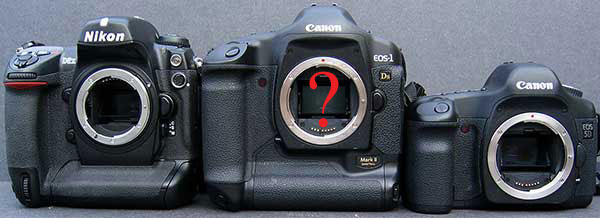
|

|

|

|

|

$220 SAVE $130 = 37.0% Western Digital 16.0TB Western Digital Ultrastar DC HC550 3.5-in… in Storage: Hard Drives
|

|

|

|

|
Goodbye Nikon?
Introduction
February 11 , 2007, updated March 3, may 3, May 8, May 30
For some time now, I’ve been considering a switch to Canon from Nikon. Yes, really.
Readers of my D2x vs EOS review know that Nikon has been my preferred shooting platform for some time—for numerous objective reasons, as well as some subjective ones. But Nikon is failing to innovate at Canon’ rapid pace, or at least in the ways I want them to innovate.
With the late-February announcement of the new Canon EOS 1D Mark III , the comparison seems very unfavorable for Nikon’s D2x and even worse for the D2H. In short, Canon’s EOS 1D Mark III is a superbly-built sports camera, offering an incredible ten (10) frames per second, and a gaggle of ground-breaking features never before available in a professional-caliber camera, including “live view”, a self-cleaning sensor, true 14-bit color, a 3" LCD, silent mode, ISO 6400, and a variety of other improvements. On paper the EOS 1D Mark III looks like an incredible camera, and I have one on order.
Two systems
Owning both Canon and Nikon systems, it’s not like I can’t shoot both—except that carrying two systems gets tedious and heavy: two chargers, two extra batteries, two lens systems and at least two bodies. To some extent, there is overlap; non-“G” Nikon lenses can be used on EOS bodies using an adapter. But that means manual stop-down and manual focus. So “switching” to Canon really just means divesting myself of Nikon equipment I’m unlikely to use, while keeping items that would prove useful should Nikon’s offerings become more appealing—a camera is a tool and I need not sell all my tools, some of which are better for one job or another.
Disappointing 5D
I prize my converted Canon EOS 5D-IR for infrared use. But the 5D color rendering (stock camera) can be awful; I’m not talking about the usual Canon color “look” which Nikon shooters are apt to dislike, but rather the tendency of the 5D to produce difficult-to-correct color shifts (see D2x vs EOS), or to destroy certain colors, a fact I re-experienced with pale green reindeer lichen in Norway last fall (examples discarded out of disgust—sorry). Multiple disappointing color experiences with the 5D have caused me to conclude that while infrequent, the #1 weakness of the 5D is its color rendering. (The EOS 1Ds Mark II has no such problems). A February 2007 experience with an outdoor portrait reminded me how awful the results can be, but the conditions which cause it elude me.
The low end
To be clear, Nikon’s offerings at the low and medium end are excellent (if you can call cameras from $500 to $1600 “low end”). The Nikon D40, D40x, D50, D80 are excellent cameras, ergonomically superior in multiple ways to the equivalent Canon offerings. The Nikon D200 doesn’t just compare favorably to the Canon 5D, it surpasses it in build quality, having a sealed body, larger and easier to use buttons and other positive characteristics (see D2x vs EOS and D200 vs D2x). The 5D offers a larger viewfinder and higher resolution which for many users is the deciding factor. But at twice the price (originally $3300 vs $1600) and now still 70% more, the D200 is clearly a far better value.
In short, Nikon is extremely competitive in the sub-$2000 range, and there is currently no rational reason for a photographer looking at that class of camera to be disappointed in any way with Nikon. But at the high end, Nikon is looking weak; the remainder of this article delves explores that assertion.
Resolution
The 16.7-megapixel Canon EOS 1Ds Mark II beats the Nikon D2x—not by a lot, but it’s never less sharp. The 12.8-megapixel Canon EOS 5D beats the Nikon D200 (though not the D2x) —with higher contrast too.
The newly-announced Canon EOS 1D Mark III offers “only” 10.1 megapixels, but that pixel count is more than adequate (and indeed preferable) for many uses, and it is pixel quality that matters considerably. Canon claims true 14-bit color depth and unprecedented low noise. While absolute resolution is always a big plus, a fine print requires high quality pixels, not just high resolution. One can also hope for improved color rendering with the 1D Mark III—I’ll be assessing that carefully.
The game has changed for resolution. It’s no longer so much about absolute pixel count, but about what resolution can be achieved with the entire system. The combination of sensor resolution/photosite size and optical performance is what counts. All professional digital cameras shipped today having 8 megapixels or more often out-resolve many lenses, especially at wider apertures or at the corners/edges. A camera manufacturer that doesn’t aggressively improve the optical performance of its lens line has little to offer with a higher resolution camera body.
Focus errors
Focus Accuracy problems with the Nikon D2x have cost me not just photos but considerable time re-shooting. The D200 seems better, but I’ve concluded that Canon focus is simply more accurate (note: I haven’t proven this with objective testing, so it’s only my working theory).
See Focus Accuracy and Autofocus Accuracy—Canon EOS 1Ds Mark II / 85mm/f1.2L II USM.
The newly-announced Canon EOS 1D Mark III promises outstanding focus speed and accuracy. With its “live view” feature, achieving critical focus for static subjects offers an unprecedented ability to squeeze every bit of resolution out of the system, especially at wide apertures.
Nikon lenses
Nikon has not produced any fast “prime” (non-zoom) lens designs for many years. Nikon’s prime-lens designs are dated, not using ED glass and aspherics adequately or at all, and optically mediocre for today’s digital cameras. To add insult to injury, the fast primes are manual focus (58mm f/1.2 NOCT-Nikkor, 50mm f/1.2 AIS, 35mm f/1.4 AIS, 28 f/2 AIS, 24 f/2 AIS)—and some are not even available new anymore, or very hard to obtain.
The only relatively new Nikon non-telephoto prime that I’m aware of is the 85mm f/2.8D PC-Micro-Nikkor (a superb lens which I regularly use on my EOS 5D with an adapter). My Nikon 50mm f/1.4D is excellent optically, but plastic build and not even AF-S. The 50 f/1.8D is mediocre optically (multiple samples tested). All of the autofocus Nikon wide angle primes are f/2.8, except for the mediocre 35mm f/2D. Who wants an f/2.8 prime lens when the 17-55 f/2.8 DX is optically superior to them all?!
To its credit, the all-new Nikon 200mm f/2 and 200-400mm f/4 are both outstanding. But I hardly ever shoot them. The 17-55 f/2.8 DX and 28-70 f/2.8 AF-S are both outstanding, but they are bulky and heavy and only f/2.8. The 12-24 f/4 DX is a decent lens, but after 4 samples with optical problems, and with a slow f/4 aperture, it sits in my drawer.
Nikon seems to be concentrating its optical design resources an an endless parade of consumer-grade “DX” optics, with four (4) slow zooms starting at 18mm alone! The optics might be quite good, but the build quality is disappointing.
Canon lenses
By comparison, Canon has produced an improved 85mm f/1.2L II, and an all-new 50mm f/1.2L; these two are uniquely “fast” and optically stellar. The Canon 35mm f/1.4L is excellent (excluding corners), and very nicely built too, with autofocus. I’ll be surprised if Canon doesn’t offer an all-new fast 24mm or 28mm lens soon.
Canon’s 135mm f/2L is optically outstanding, and it autofocuses accurately and instantly, quite unlike Nikon’s dated and clunky 135mm f/2 DC, which has specially-bred chipmunks living inside to turn the focusing mechanism.
Canon offers an image stabilized 24-105L. Nikon offers only consumer-grade stabilized lenses in that range. Canon offers four (4) professional-quality (“L”) 70-200 zooms—a key focal-length range.
Canon does have some holes in its lens lineup; the stellar 200mm f/1.8L should be resurrected, the 24mm f/1.4L is marginal, and a 28mm f/1.4 is needed. The 35mm f/1.4L is outperformed by zooms in the corners, though otherwise excellent. The 24mm f/3.5L TS and 45mm f/2.8 TS need improvement (and flare badly in infrared). The 100-400 f/3.5-5.6L is an annoying push/pull design with good but not great optical performance—clearly inferior to Nikon’s 200-400 f/4 VR, though likely as good as the awkward Nikon 80-400 VR.
Canon seems to be fully aware that many photographers desire modern optical designs in fast prime lenses, with first-rate build quality. A $1599, the 50mm f/1.2L will never be a hot seller, and perhaps not even profitable, so Canon deserves kudos for spending the R&D money and building such a unique lens. Such efforts demonstrate a serious commitment to quality and innovation. No bean-counter-run company would ever produce a 50mm f/1.2L.
Full-frame
Perhaps Nikon will announce a full-frame solution soon. But I’m tired of waiting—if it’s this month at Photokina, that won’t be too late, but beyond that Nikon gets punted to my shit-list.
Full-frame isn’t all it’s cracked up to be, but Nikon has nowhere to go from the D2x resolution which is already far too demanding of optical quality. The fact is that the 5.5-micron pixels of the D2x are already too small, and thus too demanding of optical quality. Images suffer from low micro-contrast as a result, also—just compare a D2x image to an EOS 5D image.
The D2x uses a measly 43% of the area of a full-frame sensor; a full-frame camera with D2x resolution would be around 28 megapixels. Electronics can only do so much to reduce noise, and optical laws favor full-frame as modern optical designs come into play (eg Canon) with improved corner performance.
The D200 viewfinder offers an excellent viewfinder for a “DX” camera, but I’ve come around to the view of many—I like the full-frame view of the Canon EOS models (for most subjects at least). Nikon ought to include the optional magnifying eyepieces free with the D200 (DK-21M) and D2x (DK-17M).
Software
I still use Nikon Capture 4.4, which Nikon has not offered as a Universal Binary. I’ve started exploring Nikon Capture NX, which is now a Universal Binary for Apple Intel-based Macs. So far, it looks very promising.
Canon’s Digital Photo Professional has been a Universal Binary for months now, and it offers PowerMac G5 Quad performance on a MacBook Pro (now a MacBook Pro Core 2 Duo).
Nikon charges $125 for Capture NX (about $125 street price). Canon’s Digital Photo Professional is free. Why should one have to pay a premium to use RAW? Another $125 is no big deal if you’ve bought a D2x, but if you’ve gone with the $500 D40, then another $125 is a very stiff premium indeed.
Conclusions
Does Nikon even read this stuff?! Probably not. Sadly, I’m not alone, based on the feedback I’ve gotten since I first posted this article in February 2007. Nikon is at great risk of becoming a has-been in the professional market, a sad development, and one that is equally bad for Canon users; Canon needs a wolf nipping at its heels, as does Nikon.
All the good things with Nikon remain true (which I cover in great detail in D2x vs EOS). But Nikon seems to be on a consumer-driven mission, whereas Canon is innovating with the apparent aim to dominate the professional market. Pushing the envelope of both resolution and features, along with outstanding new optics, Canon is the new horse I’ll be riding with the arrival of my on-order Canon EOS 1D Mark III, while looking forward to a 22-megapixel (rumored) Canon EOS 1Ds Mark III.
Seagate 22TB IronWolf Pro 7200 rpm SATA III 3.5" Internal NAS HDD (CMR)
SAVE $100

















